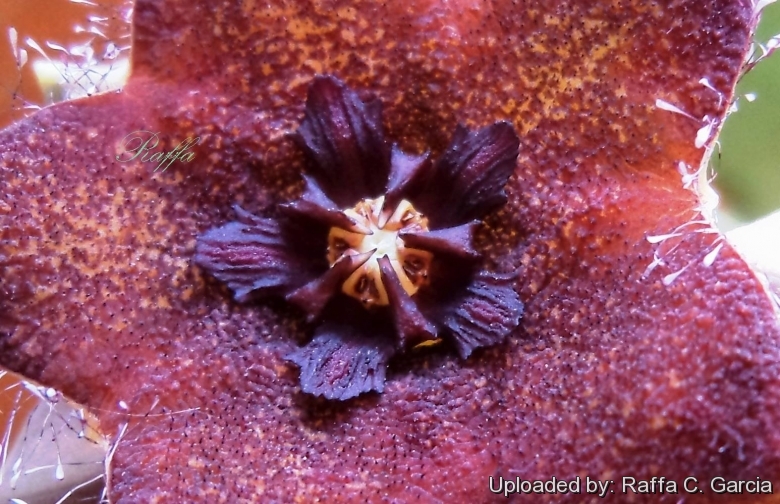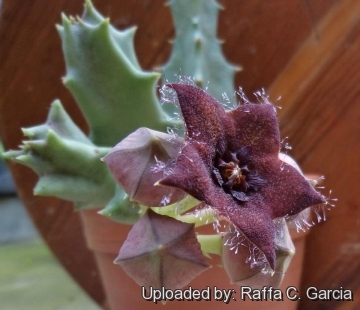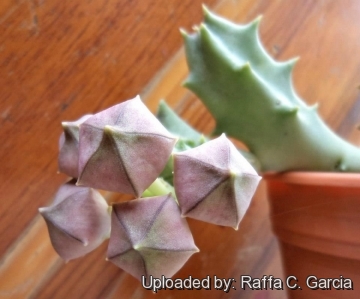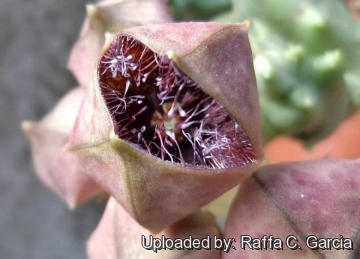Accepted Scientific Name: Orbea melanantha (Schltr.) Bruyns
Aloe 37(4): 76 2000

Caralluma melanantha (Orbea melanantha) Photo by: Raffa C. Garcia
Origin and Habitat: South Africa, Northern Province and Mpumalanga (Transvaal), Maputo district in southern Mozambique, not recorded in Zimbabwe.
Altitude range: It usually grows at altitudes above 1000 metres above sea level.
Abitat and ecology: Orbea melananthaSN|30303]]SN|30303]] grows on stony flats, interlocked with the stems of sparse shrubs, as usually seen with most members of the Stapelieae.
Synonyms:
See all synonyms of Orbea melanantha
back
Accepted name in llifle Database:Orbea melanantha (Schltr.) BruynsAloe 37(4): 76 2000Synonymy: 8
back
Description: Orbea melananthaSN|30484]]SN|30303]] (Orbeopsis melanantha) known earlier as the 'Caralluma with black flowers', is a distinct stapeliad characterized by stout stems 80-100 mm tall, the denticles on the stem teeth being very prominent on young sterns, but as the stems thicken the denticles are reduced to scars. Orbea melananthaSN|30303]]SN|30303]] is distinguished from all other species of Orbea, except Orbea luteaSN|30303]]SN|30484]], by its dense clusters of more or less simultaneously opening, uniformly coloured, dark red to almost black, and fairly large flowers (50 mm across).
Stems: Decumbent at the base, 4-angled, 5-10 cm high (to15 or more cm in cultivation), 15-25 mm across excluding teeth. Teeth 6-10 mm triangular acute spreading.
Flowers: Blackish or dark purple-brown in sessile umbels of 3-10 on a very short spur from middle or upper stem. Pedicels about 12 mm long, glabrous. Sepals 7 mm long, lanceolate, acuminate, glabrous. Corolla 3.5-5.5cm across, rotate, lobed to the middle, the disc flat without a tube. Inside closely transversely wrinkled. black-purple or rust-red, sometimes finely yellow spotted hairless to densely hairy or downy, the margins are ciliate with vibratile clavate hairs. Lobes triangular to ovate, acute or shortly acuminate about 18 mm long, 12 mm broad at the base. Outer corona-lobes erectly-spreading over corolla, oblong to obovate, connate at the lower half, semi-oblong (transversely oblong may be intended) in outline above, irregularly crenulate, slightly 4–6-grooved on the back. Inner corona-lobes ligulate, porrectly incurved above the anthers with inner horn and intricately excavated exterior at the thickened base, the horn and channel-wings usually variously ornamented.
Blooming season: Summer-autumn.
Bibliography: Major references and further lectures
1) N. E. Brown “Flora Capensis” Vol 4, page 518, 1909
2) James Cullen, Sabina G. Knees, H. Suzanne Cubey “The European Garden Flora Flowering Plants: A Manual for the Identification of Plants Cultivated in Europe, Both Out-of-Doors and Under Glass” Cambridge University Press, 11 August 2011
3) White & Sloane “The Stapelieae” edn 2 1937
4) Doreen Court “Succulent Flora of Southern Africa” CRC Press, 01 June 2000
5) Hardy & Fabian “Succulents of the Transvaal” 1992
 Caralluma melanantha (Orbea melanantha) Photo by: Raffa C. Garcia
Caralluma melanantha (Orbea melanantha) Photo by: Raffa C. Garcia Caralluma melanantha (Orbea melanantha) Photo by: Raffa C. Garcia
Caralluma melanantha (Orbea melanantha) Photo by: Raffa C. Garcia Caralluma melanantha (Orbea melanantha) Photo by: Raffa C. Garcia
Caralluma melanantha (Orbea melanantha) Photo by: Raffa C. GarciaSend a photo of this plant.The gallery now contains thousands of pictures, however it is possible to do even more. We are, of course, seeking photos of species not yet shown in the gallery but not only that, we are also looking for better pictures than those already present.
Read More... Cultivation and Propagation: It is an easy blooming plant when mature that require moderately watering through the growing season but enjoy plenty of water and some fertiliser in hot weather, this helps them to flower freely. Water more sparingly in winter according to temperatures. But, as with most asclepiads, it is unwise to leave them wet in cold weather. Winter care presents no problems at 5°C with plenty of light. Since roots are quite shallow, use a cactus mix or add extra perlite or pumice to regular soil potting soil. A gritty, very free-draining compost is suitable, and clay pots help the plants to dry out between watering.
Sun Exposure: Partial sun or light shade
Pest and diseases: Stapelia species vary in their susceptibility to rotting, but are generally fairly easy to grow, especially if kept pest-free. They are very susceptible to stem and root mealy bugs, and damage from these may well initiate fungal attack. If you do have problems with a stem or with basal rotting, you can reliably isolate the healthy parts, dry them off, and re-root them in moist compost.
Cultural Practices: Re-pot every 2 years
Propagation: Easiest with stem cuttings. Allow cuttings to dry a day before planting. Stems must be laid (Not buried) on gritty compost and will then root from the underside of the stems. It can also be increased from seeds sowing in spring in moist, sandy peat moss.
Potting medium: Since roots are quite shallow, use a cactus mix or add extra perlite or pumice to regular soil potting soil. A gritty, very free-draining compost is suitable, and clay pots help the plants to dry out between watering.













